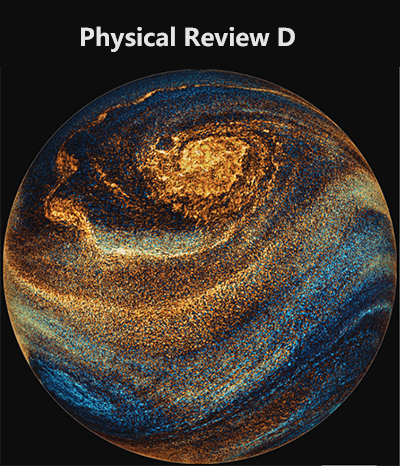夸克-强子交叉中子星准正态模的普遍性
IF 5.3
2区 物理与天体物理
Q1 ASTRONOMY & ASTROPHYSICS
引用次数: 0
摘要
我们发现QHC EOS的$f$模频率基本小于强子EOS的$p_1$模频率,主要集中在具有固定质量的中子星模型上。我们还发现,用各种强子EOS推导出的$f$模频率乘以恒星质量作为恒星紧度的函数或作为无量纲潮汐变形性的函数的通用性,甚至可以与QHC EOS保持一致。也就是说,利用这些普遍关系,我们无法区分QHC EOS和强子EOS。相反,利用这些关系可以提取恒星半径,其从低质量中子星到高质量中子星的演化可以区分QHC和强子eos。另一方面,我们发现QHC EOS的$p_1$模频率乘以恒星质量在一定质量范围内与各种强子EOS得到的相应经验关系显著偏离,这可以区分QHC EOS与强子EOS。本文章由计算机程序翻译,如有差异,请以英文原文为准。
Universality in quasinormal modes of neutron stars with quark-hadron crossover
We examine the gravitational wave frequencies of the fundamental ($f$-) and 1st pressure ($p_1$-) modes excited in the neutron star models constructed with the quark-hadron crossover (QHC) type equations of state (EOS). We find that the $f$-mode frequencies with QHC EOS basically are smaller and the $p_1$-mode frequencies with QHC EOS are larger than those with hadronic EOS, focusing on the neutron star model with a fixed mass. We also find that the universality in the $f$-mode frequencies multiplied by the stellar mass as a function of the stellar compactness or as a function of the dimensionless tidal deformability, which is derived with various hadronic EOSs, can keep even with QHC EOS. That is, using these universal relations, one cannot distinguish QHC EOS from hadronic EOSs. Instead, using the relations one can extract the stellar radii whose evolution from low to high mass neutron stars can differentiate QHC from hadronic EOSs. On the other hand, we find that the $p_1$-mode frequencies multiplied by the stellar mass with QHC EOS significantly deviate in a certain mass range from the corresponding empirical relations derived with various hadronic EOSs, with which one may distinguish QHC EOS from hadronic EOSs.
求助全文
通过发布文献求助,成功后即可免费获取论文全文。
去求助
来源期刊

Physical Review D
ASTRONOMY & ASTROPHYSICSPHYSICS, PARTICLES-PHYSICS, PARTICLES & FIELDS
CiteScore
9.30
自引率
36.00%
发文量
3456
期刊介绍:
Physical Review D (PRD) is a leading journal in elementary particle physics, field theory, gravitation, and cosmology and is one of the top-cited journals in high-energy physics.
PRD covers experimental and theoretical results in all aspects of particle physics, field theory, gravitation and cosmology, including:
Particle physics experiments,
Electroweak interactions,
Strong interactions,
Lattice field theories, lattice QCD,
Beyond the standard model physics,
Phenomenological aspects of field theory, general methods,
Gravity, cosmology, cosmic rays,
Astrophysics and astroparticle physics,
General relativity,
Formal aspects of field theory, field theory in curved space,
String theory, quantum gravity, gauge/gravity duality.
 求助内容:
求助内容: 应助结果提醒方式:
应助结果提醒方式:


